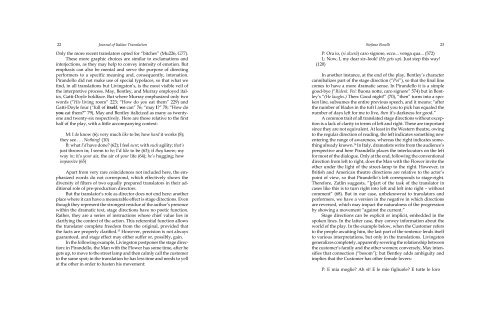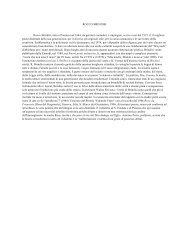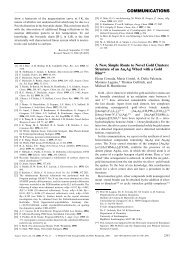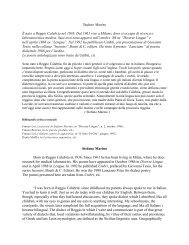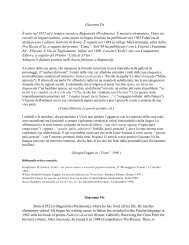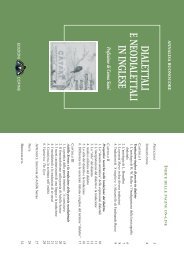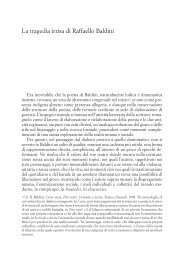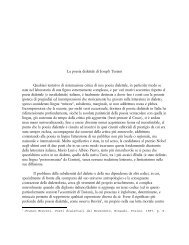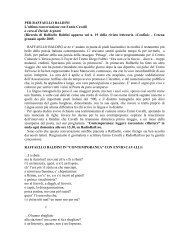Journal of Italian Translation - Brooklyn College - Academic Home ...
Journal of Italian Translation - Brooklyn College - Academic Home ...
Journal of Italian Translation - Brooklyn College - Academic Home ...
You also want an ePaper? Increase the reach of your titles
YUMPU automatically turns print PDFs into web optimized ePapers that Google loves.
22 <strong>Journal</strong> <strong>of</strong> <strong>Italian</strong> <strong>Translation</strong><br />
Stefano Boselli<br />
23<br />
Only the more recent translators opted for “bitches” (Mu226, G77).<br />
These more graphic choices are similar to exclamations and<br />
interjections, as they may help to convey intensity <strong>of</strong> emotion. But<br />
emphasis can also be mental and serve the purpose <strong>of</strong> directing<br />
performers to a specific meaning and, consequently, intonation.<br />
Pirandello did not make use <strong>of</strong> special typefaces, so that what we<br />
find, in all translations but Livingston’s, is the most visible veil <strong>of</strong><br />
the interpretive process. May, Bentley, and Murray employed italics,<br />
Gatti-Doyle boldface. But where Murray emphasized only two<br />
words (“His living room” 223; “How do you eat them” 229) and<br />
Gatti-Doyle four (“full <strong>of</strong> itself, we can” 76; “may I?” 78; “How do<br />
you eat them?” 79), May and Bentley italicized as many as twentyone<br />
and twenty-six respectively. Here are those relative to the first<br />
half <strong>of</strong> the play, with a little accompanying context:<br />
M: I do know (6); very much like to be; how hard it works (8);<br />
they see . . . Nothing! (10)<br />
B: what I’d have done? (62); I feel sure; with such agility; that’s<br />
just thrown in; I seem to be; I’d like to be (63); if they knew; my<br />
way in; it’s your air, the air <strong>of</strong> your life (64); he’s hugging; how<br />
impassive (65)<br />
Apart from very rare coincidences not included here, the emphasized<br />
words do not correspond, which effectively shows the<br />
diversity <strong>of</strong> filters <strong>of</strong> two equally prepared translators in their additional<br />
role <strong>of</strong> pre-production directors.<br />
But the translator’s role as director does not end here: another<br />
place where it can have a measurable effect is stage directions. Even<br />
though they represent the strongest residue <strong>of</strong> the author’s presence<br />
within the dramatic text, stage directions have no poetic function.<br />
Rather, they are a series <strong>of</strong> instructions whose chief value lies in<br />
clarifying the context <strong>of</strong> the action. This referential function allows<br />
the translator complete freedom from the original, provided that<br />
the facts are properly clarified. 15 However, precision is not always<br />
guaranteed, and stage effect may either suffer or, possibly, gain.<br />
In the following example, Livingston postpones the stage direction:<br />
in Pirandello, the Man with the Flower has some time, after he<br />
gets up, to move to the street lamp and then calmly call the customer<br />
to the same spot; in the translation he has less time and needs to yell<br />
at the other in order to hasten his movement:<br />
P: Ora io, (si alzerà) caro signore, ecco... venga qua... (572)<br />
L: Now, I, my dear sir–look! (He gets up). Just step this way!<br />
(120)<br />
In another instance, at the end <strong>of</strong> the play, Bentley’s character<br />
cannibalizes part <strong>of</strong> the stage direction (“Poi”), so that the final line<br />
comes to have a more dramatic sense. In Pirandello it is a simple<br />
good-bye (“Riderà. Poi: Buona notte, caro signore” 574) but in Bentley’s<br />
“(He laughs.) Then: Good night!” (70), “then” turns into a spoken<br />
line, subsumes the entire previous speech, and it means: “after<br />
the number <strong>of</strong> blades in the tuft I asked you to pick has equaled the<br />
number <strong>of</strong> days left for me to live, then it’s darkness for good.”<br />
A common trait <strong>of</strong> all translated stage directions without exception<br />
is a lack <strong>of</strong> clarity in terms <strong>of</strong> left and right. These are important<br />
since they are not equivalent. At least in the Western theatre, owing<br />
to the regular direction <strong>of</strong> reading, the left indicates something new<br />
entering the range <strong>of</strong> awareness, whereas the right indicates something<br />
already known. 16 In Italy, dramatists write from the audience’s<br />
perspective and here Pirandello places the interlocutors on the left<br />
for most <strong>of</strong> the dialogue. Only at the end, following the conventional<br />
direction from left to right, does the Man with the Flower invite the<br />
other under the light <strong>of</strong> the street-lamp to the right. However, in<br />
British and American theatre directions are relative to the actor’s<br />
point <strong>of</strong> view, so that Pirandello’s left corresponds to stage-right.<br />
Therefore, Zatlin suggests, “[p]art <strong>of</strong> the task <strong>of</strong> the translator in<br />
cases like this is to turn right into left and left into right – without<br />
comment” (68). But in our case, unbeknownst to translators and<br />
performers, we have a version in the negative in which directions<br />
are reversed, which may impact the naturalness <strong>of</strong> the progression<br />
by showing a movement “against the current.”<br />
Stage directions can be explicit or implicit, embedded in the<br />
spoken lines. In the latter case, they convey information about the<br />
world <strong>of</strong> the play. In the example below, when the Customer refers<br />
to the people awaiting him, the last part <strong>of</strong> the sentence lends itself<br />
to various interpretations, but only in the translations. Livingston<br />
generalizes completely, apparently severing the relationship between<br />
the customer’s family and the other women; conversely, May intensifies<br />
that connection (“bosom”); but Bentley adds ambiguity and<br />
implies that the Customer has other female lovers:<br />
P: E mia moglie? Ah sì! E le mie figliuole? E tutte le loro


